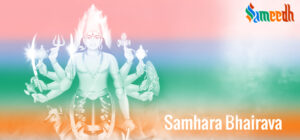In Hinduism, Samhara Bhairav is indeed recognized as a specific form of Bhairav, a fierce aspect of Lord Shiv. Bhairav is often associated with various aspects of destruction and transformation, and Samhara Bhairav specifically represents the aspect of dissolution or annihilation.

This form of Bhairav is associated with destruction and dissolution. Devotees may seek the blessings of Samhara Bhairav for the removal of obstacles and negative forces. Here are some key aspects associated with Samhara Bhairav as a form of Bhairav:
- Dissolution and Destruction: The name “Samhara” itself means destruction or dissolution. Samhara Bhairav is often invoked for the purpose of bringing an end to something, whether it be negative forces, obstacles, or even the ignorance that hinders spiritual progress.
- Iconography: Samhara Bhairav is typically depicted with a fierce and awe-inspiring appearance. He may be adorned with various symbols of destruction, such as skulls, weapons, and a garland of severed heads. This iconography symbolizes the transcendence of the ego and the impermanence of the material world.
- Worship and Devotion: Devotees may worship Samhara Bhairav to seek protection, overcome challenges, and to facilitate spiritual growth through the destruction of obstacles and ignorance. The worship may involve specific rituals, prayers, and offerings.
- Mantras and Tantric Practices: Specific mantras and Tantric practices are associated with Samhara Bhairav. Tantric traditions often emphasize the use of sacred sounds (mantras), visualizations, and rituals for invoking the transformative and protective energies of the deity.
- Role in Hindu Cosmology: In the broader context of Hindu cosmology, Samhara Bhairav plays a role in the cyclical process of creation, preservation, and dissolution. The destructive aspect is seen as necessary for the regeneration and renewal of the universe.
The worship of Samhara Bhairav is part of the larger Bhairav tradition within Hinduism, and it may vary in details based on regional practices and specific sects. Devotees seek the blessings of Samhara Bhairav for both protection from external threats and the inner transformation required for spiritual evolution.
